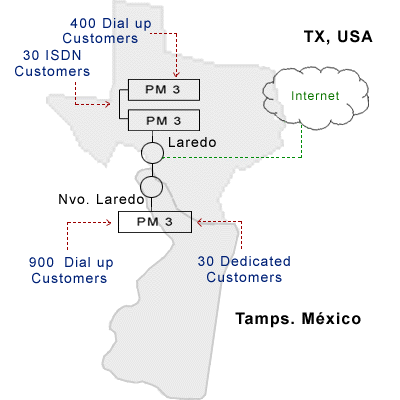GlobalPC solves transborder signaling problem with Lucent PortMaster3s

Background
With only 20 employees and two points of presence (POPs), GlobalPC is what some might consider a start-up in the Internet service provider (ISP) industry. But the company is a pioneer in providing robust Internet access for customers on both sides of the US-Mexico border. GlobalPC began operations in August, 1995 at its central site location in Nuevo Laredo, Mexico, just across the border from Texas and about 200 miles Northwest of the Gulf of Mexico. In June of 1997, GlobalPC established its second POP in Laredo, Texas, and thus increased its dial-up access business by almost 50 per cent in less than two years.
The Challenge
GlobalPC's management wants to continue growing the business and plans to expand their Internet presence in additional cities throughout Mexico and South Texas. But, until recently, the company had a problem that frustrated its mission. The R signaling used by its local telco, Telmex, did not support cross-border E1 connections for GlobalPC's existing InterNetworking Systems equipment. And that meant expansion plans were stalled until some kind of an alternative hardware solution could be found.
The Lucent Solution
Enter: Lucent's PortMaster® 3 Integrated InterNetworking Systems Server. The PortMaster 3 integrates the Lucent InterNetworking Systems Unit's True Digital modem technology, K56flex modem support, ISDN capability, CSU/DSUs, a communications server, and a router into a compact 3.5-inch chassis. The consolidation of these separate InterNetworking Systems functions dramatically reduces the support burden for installation, administration, and management. What's more, the dynamic WAN architecture of the PortMaster 3 enables automatic switching between ISDN and analog modem calls. The PortMaster 3 combines these features with WAN support for Frame Relay and synchronous leased lines, including channelized T1 or E1 signaling, to offer the most complete and flexible InterNetworking Systems solution available.
As soon as they saw how quickly the PortMaster 3 could be installed and configured for their network and realized that it completely solved their performance problems with R2 signaling, GlobalPC's technical and management staff ordered the deployment of PortMaster 3s at both of their POPs, as shown in the Figure below. Within the next 6 months, the company will also install two more PortMaster 3s at their central site in Nueva Laredo, a third at their location in Texas, and a fourth at a new site in Monterrey, Mexico.

Figure: GlobalPC's Transborder Internet Network
Customer Benefits: reliability, interoperability, and time to "shoot the breeze"
"There were many benefits we saw in deploying the PortMaster 3," explains Carlos A. Vazquez Fernandez, President of GlobalPC. "First was the ease and speed of installation. When we asked our local Lucent distributor, Enrique Leiva of Mexico City-based SATEC (Soluciones y Apoyos Tecnologicos), how long it would take to install the PortMaster 3, Enrique said, 'Two Hours. It will take 15 minutes to do the actual install. It will take the additional 1 hour and 45 minutes just to shoot the breeze.' We thought the guy was joking. But, as it turned out, we were up and running with the PortMaster 3 even sooner than Enrique predicted!"
"Even more important," observes Carlos' associate, Eduardo Cañamar Ferrara, "we knew the PortMaster 3 would continue delivering reliable service. And, of course, the capacity of the PortMaster 3 to solve our R2 signaling problem has been critical to the fulfillment of our long-term growth. Over all, we couldn't be happier."